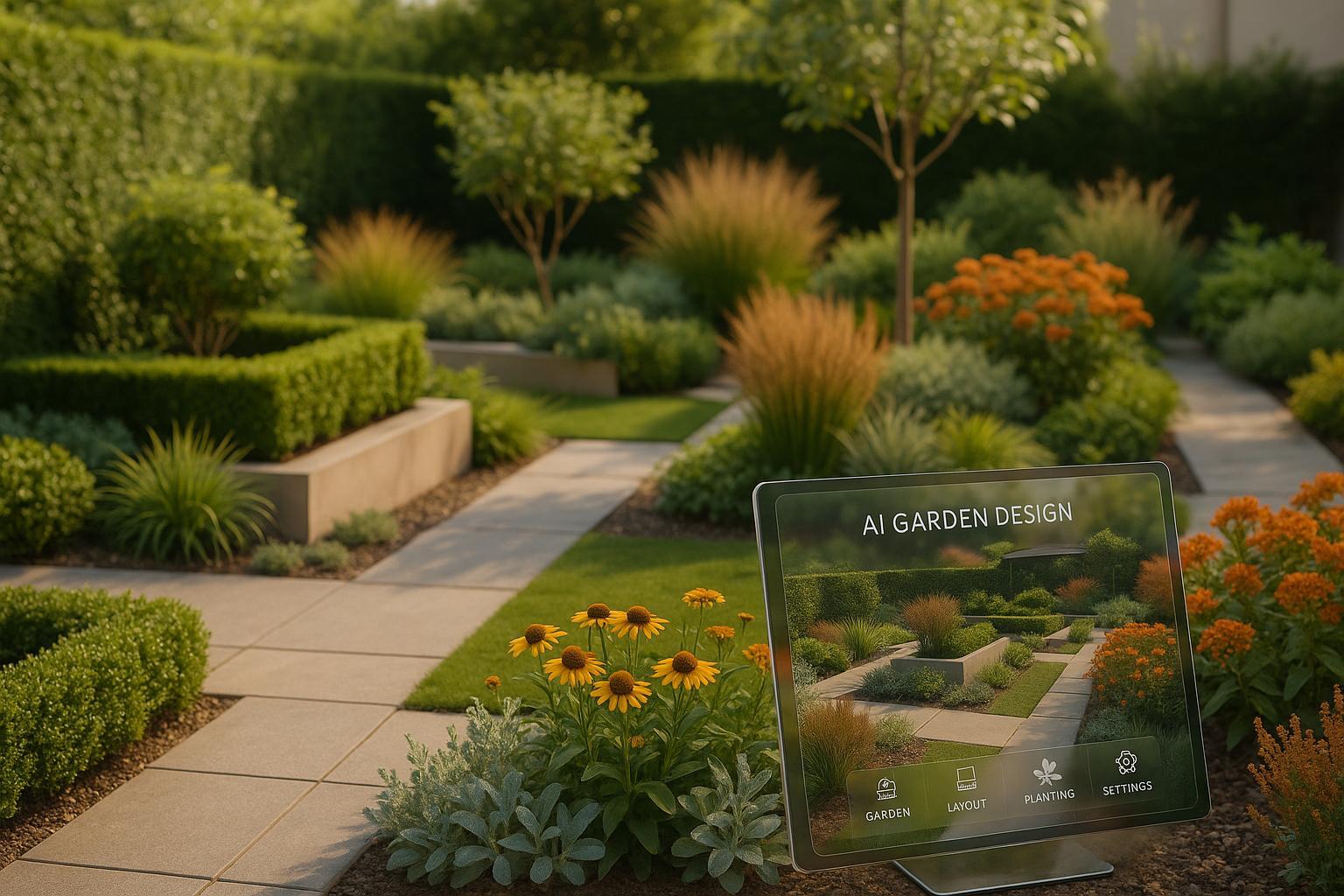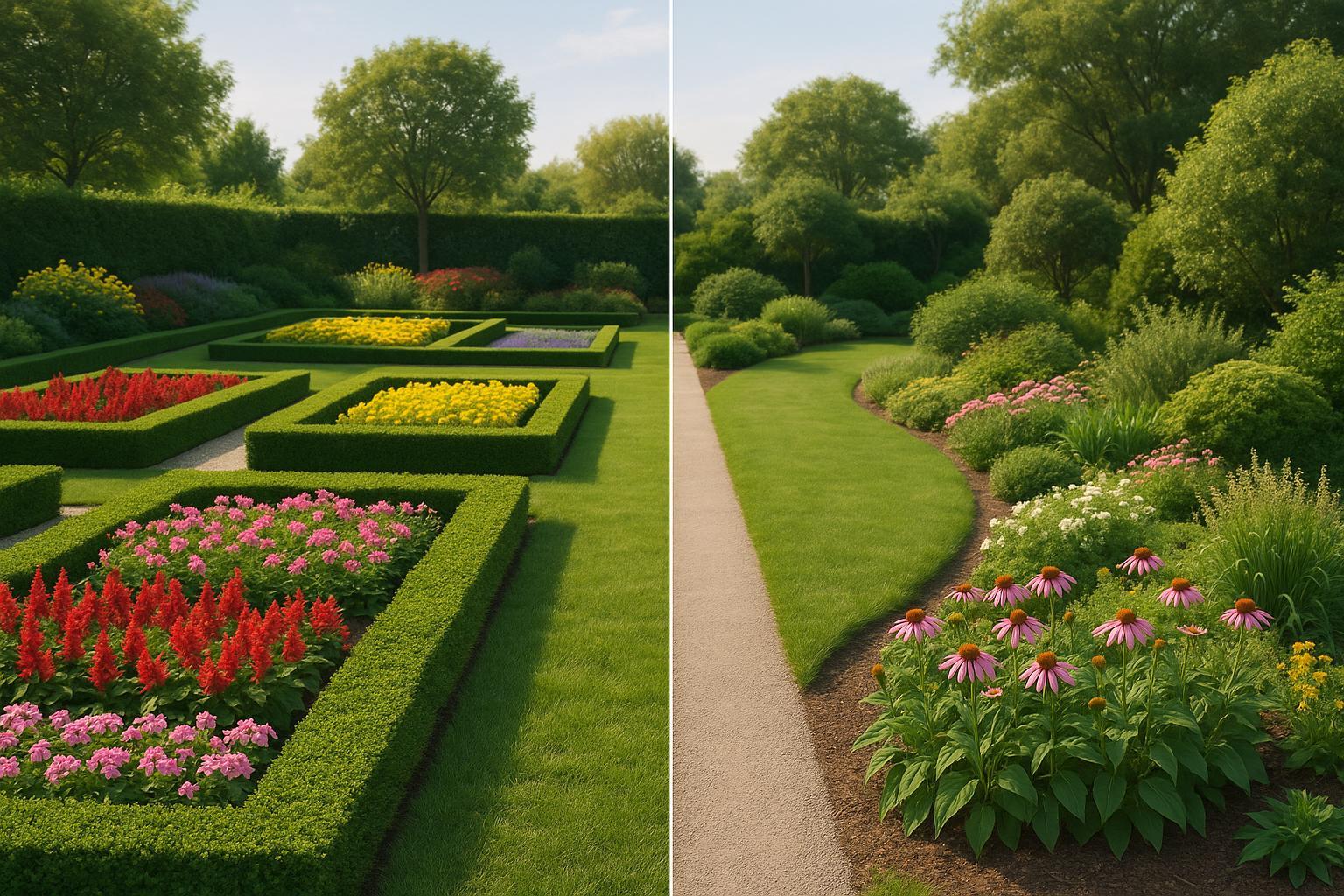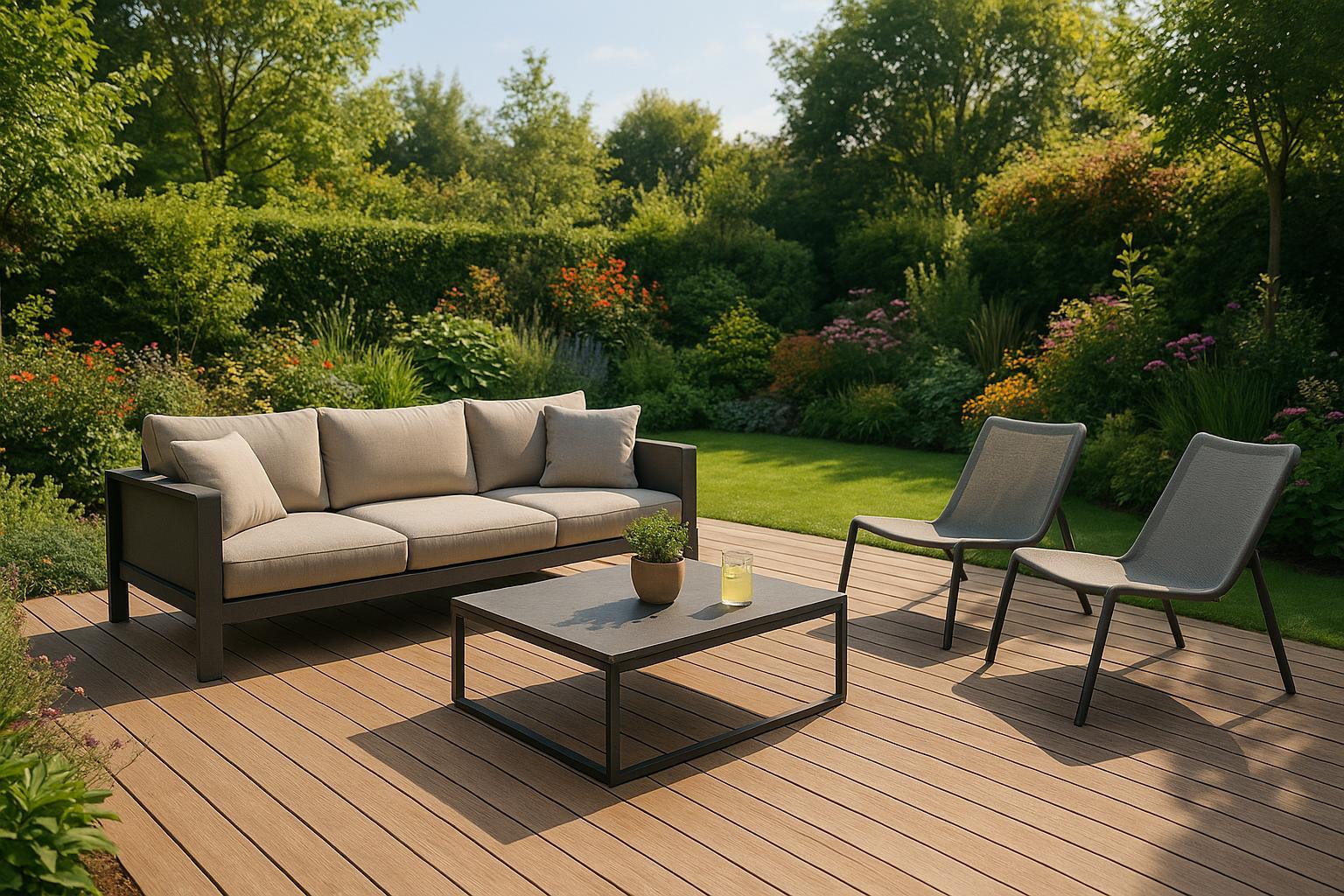Digital vs Traditional Garden Design: Pros and Cons

Garden design has two main approaches: digital tools and manual methods. Each offers distinct advantages and challenges, making the choice depend on your project needs.
Key Takeaways:
- Digital Tools:
- Precise, efficient, and easy to revise.
- Features like plant databases, seasonal growth simulations, and cloud storage.
- Ideal for large-scale or collaborative projects.
- Manual Methods:
- Personal and hands-on, fostering creativity.
- Requires basic tools like drafting boards and pencils.
- Best for small, intimate gardens.
Quick Comparison:
| Feature | Digital Design | Manual Design |
|---|---|---|
| Cost | $200–$6,000+ | $50–$1,500 |
| Time Efficiency | Quick revisions | Redrawing takes time |
| Flexibility | Consistent and scalable | Encourages artistic expression |
| Precision | Automated measurements | Manual calculations |
| Storage | Cloud-based, easy to share | Physical sketches only |
| Best For | Large, complex, or collaborative projects | Small, personal projects |
For the best results, consider combining both methods: start with hand-drawn sketches for creativity and refine with digital tools for precision.
Digital Garden Design Tools
Main Digital Tool Features
Digital garden design tools make planning and visualizing your garden easier. They include detailed plant databases that help match plants to your local climate and garden layout. Some tools even show how plants change with the seasons, giving you a clear picture of what to expect over time. With cloud-based functionality, you can access and update your designs from any device with internet access, making it convenient to work on your garden plans wherever you are.
Benefits of Digital Design
Virtual planners allow you to test out different layouts, colors, textures, and plant heights without having to make physical changes. This saves time and helps avoid expensive mistakes.
"I love the simplicity of use, the great selection of plants and materials, the ability to use my iPad and iPhone to design and the ease of emailing the project to the client." – EG
One standout feature is the ability to predict future growth. These tools can simulate plant growth rates and show how your garden will look as it matures. This helps you decide on plant spacing and arrangements, ensuring your garden looks well-balanced right after planting and as it develops over the years.
Manual Garden Design Methods
Basic Manual Design Tools
Designing a garden manually relies on a set of essential tools. A typical setup includes a 24" x 36" drafting board and lighting at 530 lux for accuracy. For measurements, you'll need an Architect's Scale and an Engineer's Scale. The Chartpak Adjustable Triangle helps create parallel angles, while tools like the Kohinoor Technigraph Lead Holder and Copic Multiliner Technical Pen Set ensure clean, precise sketches. These basics provide a strong starting point for crafting thoughtful designs.
Benefits of Manual Design
Drawing by hand creates a deeper connection to the garden space. May Sarton captures this sentiment beautifully:
"Everything that slows us down and forces patience, everything that sets us back into the slow circles of nature, is a help. Gardening is an instrument of grace."
When you measure and sketch your garden manually, you notice details that might escape you on a screen. For instance, you may observe how shadows shift throughout the day or how existing features complement your planned changes.
Limits of Manual Design
Manual methods come with their challenges. As DRAFTSCAPES explains:
"The first thing that I want to make note of is that you should not delay practicing your drafting, or waiting to draw landscape designs just because you feel you don't have the 'right' materials".
This highlights a common issue: the reliance on specific tools. Adjusting designs often means redrawing sections, which can be time-consuming. Precision is especially critical in smaller gardens. As one expert advises, "When designing a small garden, take your time and be really careful with the plants you choose because a small garden has to work a lot harder than a big garden".
| Tool Category | Products | Key Benefits |
|---|---|---|
| Lighting | OttLite LED Crane Lamp | Improves visibility, reduces eye strain |
| Drawing Surface | Blick Portable Drafting Board | Ensures stability, includes parallel ruler |
| Drawing Tools | Pentel Graphgear Mechanical Pencil Set | Offers precision and varied line weights |
| Color Implementation | Prismacolor Set | Professional-grade and widely available |
Software choices for Garden Designers or Landscape Architects!

sbb-itb-4d6a8dd
🚀 Ready to Reinvent Your Garden?
Join thousands of homeowners who have transformed their gardens using our AI design tool. Upload one photo to explore endless possibilities.
Get your AI garden designs →Digital vs Manual Design Comparison
When comparing digital and manual garden design methods, several factors come into play, influencing their suitability for different projects. Here's a breakdown of the key differences between the two approaches.
Feature Comparison Chart
| Feature | Digital Design | Manual Design |
|---|---|---|
| Cost | Basic digital sketches range from $200–$600, while detailed 3D renderings can cost $2,000 to $6,000+ | Hourly rates for manual design range from $50–$150, with project fees typically between $300 and $1,500 |
| Time Efficiency | Allows for quick revisions and adjustments | Redrafting can slow down the revision process |
| Design Flexibility | Ensures consistent elements and efficient planning | Encourages artistic expression and spontaneity |
| Precision | Uses automated tools for exact measurements | Relies on manual calculations |
| Storage | Digital designs can be saved and backed up on cloud platforms | Requires physical storage for sketches and drafts |
| Collaboration | Easily shareable and editable digital files | Collaboration is limited to sharing physical copies |
Cost, revision speed, and precision often differ significantly between these methods. For instance, digital tools are ideal for larger projects that demand accuracy and scalability. On the other hand, manual designs can add a personal, artistic touch to smaller, more intimate projects.
A hybrid approach might be the best of both worlds. For example, you could sketch initial ideas by hand, scan them, and refine the details using digital tools. Alternatively, start with a digital draft for precision, then print it out to add creative elements manually.
Ultimately, the choice depends on your project goals. A small backyard redesign may benefit from the charm of hand-drawn sketches, while larger commercial projects often require the precision and efficiency of digital tools. Combining both methods can help you achieve a balance between creativity and accuracy.
Selecting Your Design Method
Decision Points
When deciding on a garden design method, think about these key factors:
- Project Scale: Small gardens work well with manual sketches, while large-scale projects benefit from the precision of digital tools.
- Technical Comfort: Digital tools come with advanced features but may require some tech skills to use effectively.
- Budget: Manual methods need only basic supplies like graph paper and pencils. Digital tools cost more upfront but can save time and effort with reusable templates.
- Timeline: Tight deadlines? Digital tools allow quick revisions. For more creative, free-flowing ideas, hand sketching is often better.
These considerations will help you choose the right approach for your project.
Best Uses for Digital Tools
Digital tools are ideal for:
- Complex Projects: They handle intricate layouts, like multi-zone gardens or detailed hardscapes, with high accuracy.
- Client Presentations: Digital renderings are polished, easy to share, and simple to update.
- Team Collaboration: Cloud-based tools make it easier to share files and coordinate with clients, contractors, or team members.
Best Uses for Manual Methods
Manual methods are perfect for:
- Brainstorming and Creativity: Hand sketching is great for quickly exploring ideas and experimenting with concepts.
- Personal Gardens: Adding a personal touch to residential projects is easier with hand-drawn designs.
Using Both Methods Together
Sometimes, combining both methods works best:
1. Start with Sketches, Refine Digitally
Begin with hand-drawn ideas to explore concepts, then scan and refine them using digital tools for precision.
2. Digital Base, Manual Details
Create an accurate digital base plan and add artistic or creative elements by hand for a custom feel.
3. Digital Mapping, Manual Exploration
Document property details digitally, then print base maps to experiment with designs manually.
Conclusion
Garden design continues to change with the integration of digital tools, which improve precision, efficiency, and collaboration. At the same time, traditional methods remain essential, offering a personal and emotional connection to the creative process.
Main Points Review
The choice between digital and manual design methods depends on your specific needs. Digital tools provide accurate measurements, quick updates, and easy sharing, making them practical for many projects. On the other hand, hand-drawn designs bring a personal, artistic touch that fosters a deeper connection to the design.
Combining both approaches can often deliver the best results:
| Design Phase | Recommended Method | Key Benefit |
|---|---|---|
| Initial Concept | Manual Sketching | Encourages creativity and quick ideas |
| Detail Development | Digital Tools | Ensures precision and easy adjustments |
| Client Presentation | Hybrid Approach | Balances professional polish and warmth |
| Final Documentation | Digital Format | Simplifies sharing and future updates |
Related posts
Related Articles

How AI Adjusts Garden Styles Instantly
Unlock the power of AI in garden design with instant customization, eco-friendly plant suggestions, and professional-quality layouts tailored to your space.

Modern Garden Styles: Top 8 Trends for 2025
Explore the top 8 garden trends for 2025, blending technology, sustainability, and aesthetics for modern outdoor spaces.

AI Garden Layouts vs. Traditional Design Methods
Explore the pros and cons of AI garden design tools versus traditional design methods, and find the best approach for your project needs.

AI Garden Styles for Every Season
Transform your garden throughout the year with tailored seasonal designs and plant recommendations based on local climate conditions.

AI-Driven Garden Furniture Placement: How It Works
Transform your garden with AI-driven furniture placement that optimizes style, comfort, and functionality based on your space and preferences.

AI-Driven Rainfall Schedules for Every Climate
Utilize AI-driven rainfall schedules to enhance garden planning, conserve water, and ensure optimal plant care based on local climate conditions.